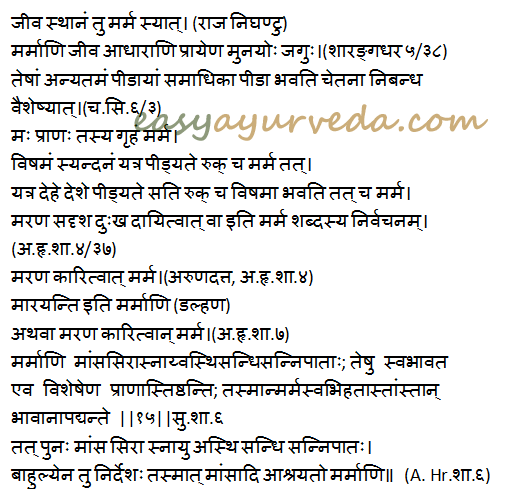Marma Shaareera: Definition, Composition: Vital Points of The Body
Article by Dr Raghuram Y.S. MD (Ay) and Dr Manasa, B.A.M.S
The section of ‘Shareera Sthana’ of ‘Sushruta Samhita’ explains about Marma shareera – science of vital points and delicate structures of the body’ is immense. This also seems to be the first and earliest reference of the explanation of ‘surgical anatomy’ or ‘applied anatomy’.
All the ancient Ayurveda teachers including Charaka and Vagbhata have enumerated Marmas and the impact of their insult or injury on the health and life. While the other Acharyas have mentioned 3 Marmas, Sushruta has managed to identify 107 Marma points in the body, the injury of which can cause one or more of deformity, pain, gradual death and almost instant death. The knowledge of these points also would help the surgeons to put their instrument on the body parts wherein these Marmas are absent or to conduct the surgery without harming these vital points or areas of the body.

Table of Contents
What is Marma?
According to Raja Nighantu and Sharangadhara –
Marmas are the seats of Jeeva or life. This means to tell that marmas are important points where life element exists. Any injury or damage would harm the life. Collective damage may have a serious impact. Sharangadhara also mentions Marmas as Prana adharas or sites of prana or life element.
According to Charaka –
Marmas are those sites of the body wherein the sensation of pain is felt more intensively in comparison to the other parts of the body. This occurs due to the association of chetana or life element with these points.
Thus, according to Charaka, Marma is any point in the body which is associated with life element and is more sensitive to pain.
Marma according to Vagbhata –
The split term Mah or Ma of Marma denotes Prana or life. Ma also denotes residence. Hence, the residence of Prana is Marma. Or, the point or points of the body in which the Prana or life element resides is called Marma. Marma is further defined as the place or point wherein an injury leads to vishama syandana (irregular pulsations), peedaa (misery, physical and mental misery) and ruk (pain). Marma is further defined as the point which on injury would cause severe misery equal to that of death.
According to Arunadatta –
Arunadatta, the commentator of Ashtanga Hrudaya defines Marma as ‘that which causes marana or death is called marma’.
According to Dalhana (commentator of Sushruta Samhita) –
‘The part of the body which on injury leads to death is called Marma’
According to Sushruta –
Among all the definitions of Marma, Acharya Sushruta gives the most comprehensive and complete one.
‘Marma is the conglomeration (meeting place) of the five elements of the body namely – Mamsa (muscles, flesh), Sira (blood vessels, arteries, and veins), Snayu (ligaments, tendons, and nerves), Asthi (bones) and Sandhi (joints). As a natural phenomenon, the Pranas (life element) are seated at these places of conglomeration. Therefore, any injury to these places leads to serious consequences depending on the structure or structures predominantly involved in the marma.
Naming based on structures
Marmas are named according to the predominance of the structure in the conglomeration –
Although all the Marmas are comprised of the above mentioned Mamsa etc 5 elements, the individual structural classification applies based on the predominance of the structure (element). This means to tell that a given Marma is made up of all of the mamsa, sira, snayu, asthi and sandhi, but will be addressed by the name depending on which among the 5 structures is predominant in the given marma.
Example – Hridaya (heart) is said to be a Sira Marma. Hridaya is made up all the 5 elements or structures but is predominantly formed by Sira (blood vessels) and hence the name. Similarly, Guda marma (anus and rectum) is made up of all the elements or structures but is predominantly formed by muscles. Therefore it is classified under Mamsa (muscle predominant) marma.
Structures and Composition of Marma
The Marmas are made up of –
- Soma (kapha or watery elements)
- Maruta (Vayu or airy elements)
- Teja (Pitta or fiery elements)
- Satwa
- Raja
- Tama
- Bhuta (5 basic elements of creation, Earth, Wind, Water, Fire and Ether)
- Atma (Soul)
Satwa, Raja and Tama are the forms of ahankara (egoism) derived from macrocosm and form the basic qualities of mind.
All the above said ingredients in the composition of Marmas are called Pranas or life elements. When the marma or marmas are injured, one or more of these Pranas will be afflicted leading to death or deformity.
Apart from this, it is already mentioned that Marmas are structurally composed of –
- Mamsa
- Sira
- Snayu
- Asthi and
- Sandhi
Classification of Marmas
According to Charaka –
Marmas are 3 in number. They are Shira or Murdha (head, brain), Hridaya (heart) and Vasti (urinary bladder, urinary apparatus). Charaka has said that among all the Marmas these 3 marmas are important ones. Thus he too has accepted that there are more than 3 Marmas (107) but has named 3 of them as the most important ones. Sushruta too has included these 3 marmas in his 107 Marmas.
Sushruta’s classification of Marmas:
Sushruta has numbered the number of Marmas as 107 and has classified them in 3 different ways:
According to the location of Marmas
Shakha Gata Marmas (Marmas in the limbs i.e. both upper and both lower limbs) – 11×4 = 44 Marmas in number
Madhya Shareera Gata Marmas – (Marmas located in the trunk including thorax and abdomen) – 26 Marmas in number
Shirogata Marmas (Marmas located in the head and neck) – 37 Marmas in number
According to the composition (predominant tissue present) of the Marmas
Mamsa Marmas (predominant in muscle tissue) – 11 in number
Sira Marmas (predominant in blood vessels) – 41 in number
Snayu Marmas (predominant in ligaments, tendons) – 27 in number
Asthi Marmas (predominant in bone tissue) – 08 in number
Sandhi Marmas (predominant in bone joints) – 20 in number
According to the effect of injury on the Marmas
Sadhyo Pranahara Marmas (cause immediate death on getting injured) – 19 in number
Kalantara Pranahara Marmas (cause gradual death on getting injured) – 33 in number
Vishalyaghna Marmas (cause death when the impacted foreign body is removed from the Marma) – 3 in number
Vaikalyakara Marmas (cause deformity on getting injured) – 44 in number
Rujakara Marmas (cause severe pain on getting injured) – 8 in number
Note – The number of Marmas mentioned in the above said 3 classifications are not different. They are the same 107 Marmas classified in 3 different contexts.
Example – Hridaya or heart is a Sira Marma (structure), located in the Madhya Shareera or Uras (located in the thorax) and is a Sadhyo Pranahara Marma (effect of injury is immediate death)
Vasti (urinary bladder) is a Snayu Marma (structure), located in the Madhya Shareera or Udara (located in the abdomen) and is a Sadhyo Pranahara Marma (effect of injury is immediate death)
All other Marmas too should be understood in the same way. Thus each Marma fits into all 3 categories of classification.
Just Before Finishing –
Marma Shaareera is a part of Ayurvedic anatomy wherein many vital points, parts and organs of the body have been mentioned, 107 to be precise, the comprehensive knowledge of which is essential for the physicians, especially the surgeons. The knowledge of these Marmas helps the surgeon to protect these parts and conduct surgery with caution, so as to not injure them, thus preventing the possible complications of surgery including functional and structural damage, deformity and or death.
Click to Consult Dr Raghuram Y.S. MD (Ayu)










